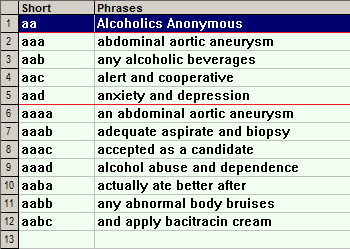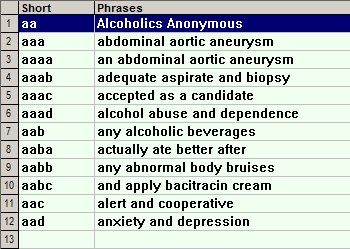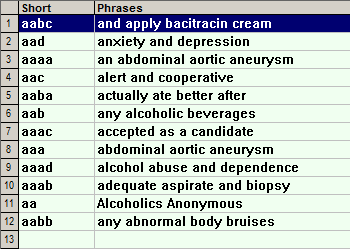
The Phrase Advisory is a table that displays phrases that match the letters you type. The phrase short forms that match the abbreviation you type, in the example below ico, are listed on the left under the Short label and the corresponding phrases on the right under the Phrases label.

Similarly as for the words, phrases with short forms that start with the abbreviation, again the traditional left-to-right completion, are displayed first:
|
|
|
|
|
And phrases with short forms for which the abbreviation skips letters are displayed next, ordered by least jump-ahead:
|
(here o is the 4th character) |
|
(here o is the 6th character) |
Remember that when abbreviating a phrase, you need to type the first two characters of its short form before you can skip letters.
Inside
these two categories of displayed matching phrases:
Phrases with short forms that start with the typed abbreviation.
Phrases with short forms for which the abbreviation skips letters.
additional ordering takes place that is driven by the Advisory Sort Options that you can define in the Advisory Options Dialog
Entries can be sorted by their short form length, and they can be sorted alphabetically. If you combine both options, the short form length takes precedence upon the alphabetical order, which means:
Entries with the shortest short forms appear first.
Entries with short forms of
same length appear in the alphabetical order.
 Entries with the shortest short forms appear first. Entries with short forms of same length (horizontal red lines have been added to the screenshot to show the groups of same length) appear in the alpabetical order. This is the default option and also the one we recommend. |  |
 Entries with the shortest short forms appear first. Entries with short forms of the same length (horizontal red lines have been added to the screenshot to show the groups of same length) appear in the order in which they are arranged in the glossary. |
 |
 Entries appear in the alphabetical order of their short forms. |  |
 Entries appear in the order in which they are arranged in the glossary. |  |
See also: Moving Glossary Entries